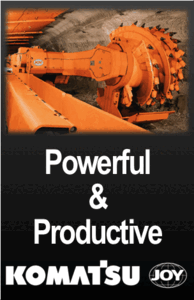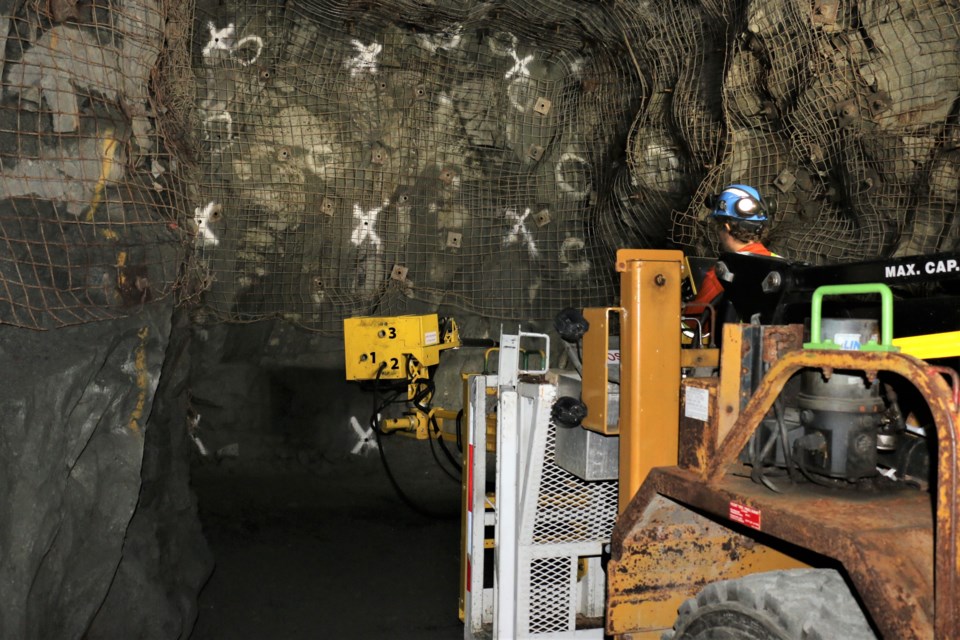
 










|
Signature Sponsor


January 21, 2024 - In Canada, researchers at Laurentian University in Sudbury are studying the harmful effects of the vibration of heavy machinery on the miners that operate that machinery. Vibration is one of several factors that can cause occupational illness according to CROSH — the Centre for Research in Occupational Safety and Health in Sudbury.
Scientists at Laurentian University are looking to find ways to reduce the harmful effects of mining machinery vibrations on the workers, such as this Sudbury miner setting up a rock bolting pattern. Photo: Len Gillis/Sudbury.com CROSH held an online safety conference Friday that included the inaugural lecture of the Leo Gerard Legacy Fund Lecture Series. Gerard, a retired and former international union leader with the United Steelworkers, is from Sudbury. He was a lifelong advocate of improving health and safety for workers. Friday's opening lecture was presented by CROSH senior scientist Dr. Katie Goggins. She explained how vibration can come from mobile equipment being used by workers, as well as from stationary equipment where the worker has hands-on the machinery, or is standing or sitting on the machinery. Goggins said that vibration is a form of a mechanical wave that infiltrates the body of the equipment operator. "Vibration can enter the body through any point that's in contact with the vibrating surface. So in the case of the seat or operator here on the right (referring to a photo of a forklift driver) there are three contact points, the back, the buttocks and the feet," said Goggins. During the lecture, examples of mining equipment that produce vibrations included a mining jumbo drill platform, a raise drill platform, or a piece of mobile equipment such as a rock bolting machine. Goggins said in some cases equipment operators experience whole body vibrations which essentially covers vibrations to the hands and arms, to the feet, ankles and legs and to the body and the spine. Goggins explored the idea of what can happen in the case of an equipment operator who is subjected to whole body vibrations over a set period of time. "By the end of the workday health effects can include muscle fatigue, discomfort, there's distorted motor performance, the operator could experience headaches, dizziness, or motion sickness," said Goggins. "The operator's heart and respiratory rates will probably increase from the vibration exposure and there could be a decreased cognitive function, impaired speech and vision and reduced vigilance," she added. Over a prolonged period the health effects could worsen and become permanent, she said. "The chronic or longer term can happen in months to years. The type of health effects will include things like lower back pain, spinal degeneration, shoulder neck pain, there could be digestive problems, for example, the suppression of gastric functions. There is a possible increase in the increased risk of prostate cancer," she said. "And finally, noise induced hearing loss. More often than not, vibration does create noise.” In the big picture, Goggins said whole body vibrations are harmful in the long term. "Ultimately, there's a lot of research finding that seated operators exposed to whole body vibration are at an increased risk of musculoskeletal disorders. With the neck, shoulder, lower back, wrist and hand, and knee pain can be possible. One thing we do know is that lower back injury risk increases when whole body vibration exposure is combined with non-neutral postures or rotated or twisted postures," she said. Goggins also spoke about the whitening or blanching of certain body areas where vibration occurs during the work period. She said research has shown this will happen with a person's feet, which is one of the less researched areas related to the effects of vibrations in the workplace. She said repetitive vibration exposure can cause the onset of Raynaud's Phenomenon, as the arteries in the hands and feet become constricted, resulting in less blood flow, which results in the blanching effect. She said research also revealed that miners (six out of 27 miners) have reported incidences of Raynaud's Phenomenon in their feet as a result of standing on drilling platforms over a period of time. In another study, she said miners have reported moderate to severe pain in their feet and toes. Goggins also remarked there are solutions to be considered to resolve the problem. Goggins said this could include removing the worker from the piece of machinery which she said was the most effective. This could involve greater use of remote-controlled mobile equipment. The problem could also be addressed by substituting the equipment with machinery that causes less vibration, which would involve specific purchasing and better engineering to either dampen or isolate the vibrations. Goggins said another solution would involve the use of more effective personal protective equipment (PPE). The CROSH webinar on Occupational Illness was also exploring research at Laurentian University on developing an instrumented insole for studying foot transmitted vibrations, studying the zone of comfort limitations for hand controls on mining vehicles, studying wearable devices to prevent heat stress for underground workers and whether over-the counter antihistamine medications can prevent heat stress. |
 








|
